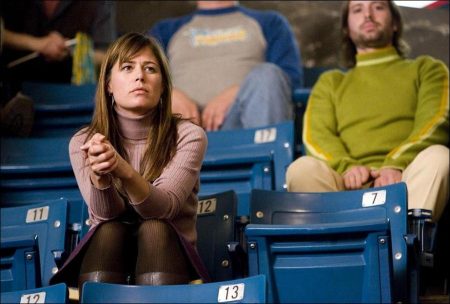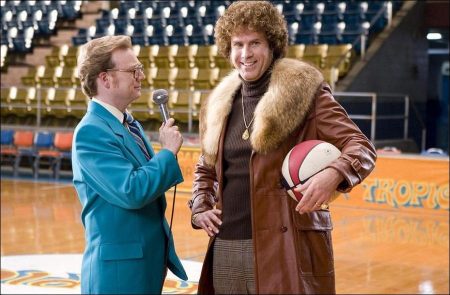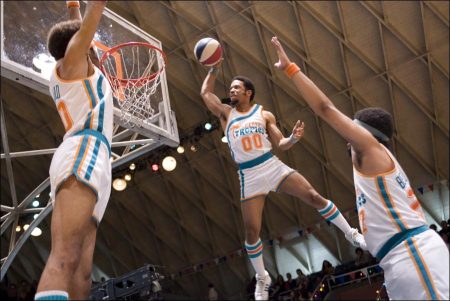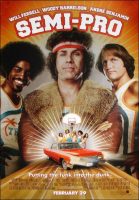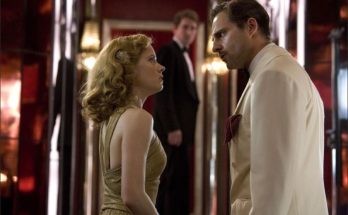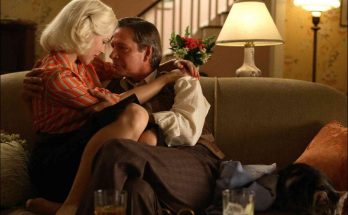In the early 1970s, there were two basketball leagues in America – while the NBA ruled the sport, the ABA was defined by its outlaw flair and sensational showmanship. Jackie Moon (Will Ferrell) is the one-hit singing sensation behind “Love Me Sexy,” who relishes his role as owner, coach and power forward for the fictional Flint, Michigan Tropics of the ABA.
But when the NBA announces a plan to merge with the ABA and only take with them the four teams with the best records, disbanding the rest of the ABA squads forever, Moon, assisted by former NBA benchwarmer Monix (Woody Harrelson) and flamboyant Clarence “Downtown” Withers (André Benjamin), decides to rally his motley team for an unlikely eleventh-hour pursuit of acceptance and glory.
Remembering The ABA
From 1967 to 1976, the American Basketball Association was a renegade basketball league that nipped at the heels of the NBA. Despite contributing some impressive innovations to the game and a style of play that emphasized flair and showmanship, the ABA was ultimately absorbed by its well-established competitor. Four of the ABA’s most successful teams remained intact following the merger – the San Antonio Spurs, Denver Nuggets, New York Nets and Indiana Pacers.
Semi-Pro is the comedic story of the Flint Tropics, a fictitious ABA team that didn’t quite make it. The Tropics bear similarities to some of the defunct teams of the ABA – the Kentucky Colonels, the Anaheim Amigos and the Spirits of St. Louis. Though these teams are no longer in existence, they have a brief cinematic reprieve in Semi-Pro, as their logos and uniforms were painstakingly reproduced for the film’s game sequences.
Perhaps the most famous player in the ABA was Julius Erving, better known as “Dr. J,” who played for the Virginia Squires and the New York Nets. Other famous ABA players who went on to NBA glory include Artis Gilmore, George Gervin and James Silas (Erving and Gervin went on to be enshrined in the Basketball Hall of Fame).
Though four of the ABA’s teams were adopted by the NBA, the leagues were very different. “There were a number of things that were different,” says Artis Gilmore, who played for the Kentucky Colonels. “Probably one of the most unusual was the basketball, the colors of the basketball itself.” The ABA basketball was red, white and blue, and it was a bit smaller than the NBA regulation-size ball. The three-point shot, now a mainstay of NBA games, was also an invention of the ABA.
“Then, of course, the environment that we had to play in,” adds Gilmore. Depending on the size of a team, ABA franchises would often share a court with a local high school or college. The huge stadium arena was not part of the ABA’s identity.
“There were a number of franchises that were not totally established,” says James Silas. “The San Diego Conquistadors, for instance, played at San Diego State. There were a number of other teams you played a game with one day and then a few weeks later you might find out they’d disbanded. That happened with the Floridians during the year that I was drafted. Stability was certainly a challenge.”
The players supplemented their stability with ingenuity and creativity. George Gervin, whose nickname is “Ice,” remembers: “We used to have marketing ploys. When I would travel into different cities, the opposing team would have try and ‘hold’ Ice Gervin under thirty points. If they were successful, everybody would get free McDonalds or free Kentucky Fried Chicken” Needless to say, they were never successful at holding Gervin down. “My goal was to go in there and get 40 points and walk out of there saying, “Nobody’s eating on Ice!'”
Some of these unusual marketing strategies are manifested in Semi-Pro via Jackie Moon’s trademark flair. Moon’s soul hit, “Love Me Sexy,” has its own parallel in the real ABA world: singer Pat Boone owned the ABA team the Oakland Oaks.
Woody Harrelson, who plays Tropics teammate Monix, remembers his childhood experiences watching the ABA. “I remember watching the ABA when I was younger and really liking Dr. J, of course. He was the guy who really made the ABA explode. There were other big players but Dr. J was the one for me at the time. At the time I didn’t know the difference between the ABA and the NBA, but I’ve learned a lot since.”
“The NBA was really where everybody wanted to be,” George Gervin recalls. “That was the best basketball in the world, but we felt that we could compete against them with our talent. We couldn’t compete with them as far as sponsorship and marketing, but we felt we had some very talented basketball players in the ABA.”
“We had our own style,” Gervin concludes. “We were a community, like a family. We went out to eat together, we played cards together. It was a family atmosphere. Once we had our chance to merge with the NBA, we took that same community and friendship with us.”
From A Flint To A Fire
Screenwriter Scot Armstrong first pitched the idea for Semi-Pro when he was in Los Angeles working on Todd Phillips’s Old School, which Armstrong co-wrote and which co-starred Will Ferrell. Initially, he couldn’t find a home for the story. “Whenever I pitched the idea I would hear, ‘It’s too crazy to recreate the ’70s,’ or ‘It’ll be too expensive’ or ‘Can you do a modern version?’ I wanted to do a real version of the ABA, which is what makes it special.” Armstrong ultimately found supporters at New Line Cinema and the project was set in motion.
For Armstrong, Semi-Pro is the culmination of a lifelong affection for basketball. “As a kid I loved the ABA stuff. I even had a Dr. J ball. I liked the NBA, but the ABA invented the three point line and the slam dunk. They were the funkier, cooler league and I liked them better.”
He took the independent, free-spirited sensibility of the ABA and the relaxed lifestyle that characterized the swinging ’70s and found opportunities for comedy to flourish. “It seemed like a big idea and a big world,” says Armstrong. “We recreated a league in the ’70s with all the exact same logos, the same league, the same teams.”
Although Armstrong made a concerted effort to infuse the script with authenticity, everything about the Flint Tropics of Michigan is fictional. Nevertheless, the Tropics are similar in spirit – and game attendance – to many of the teams that made up the ABA. “The Flint Tropics don’t get very many fans,” Armstrong says. “In fact, in the first game there are about ninety people in the stands. Will Ferrell’s character, Jackie Moon, is the owner, coach, player and the best promoter in the league – or at least he’s the most flamboyant. It doesn’t always work but he’ll go to extremes to get people into the seats.”
Those extremes gave Armstrong many opportunities to create the enthusiastic, proud and sometimes goofy character of Jackie Moon. Will Ferrell’s seemingly limitless comedic abilities inspired Armstrong to come up with inspired dialogue and situations. “There’s nothing more fun as a screenwriter than writing in the voice of Will Ferrell,” Armstrong says. “I’d be typing and I’d start cracking up because I’d get a picture of him doing what’s written. He can do things that other people just can’t do. You can write a really simple scene and he takes it to the next level. He makes you look good as a writer.”
“I’d always kicked around the idea of doing a basketball film and I’m a big fan of the game, so when Scot told me he was working an idea for a movie about an ABA team, I thought it could be a lot of fun,” says Ferrell. “I’m so glad he followed through on it.”
Drafting The Team
When the time came to enlist a director, the producers and New Line Cinema found an inspired candidate in Kent Alterman, who makes his directorial debut with Semi-Pro.
A former East Coast Head of Development for Comedy Central and writer/producer/director for Michael Moore’s acclaimed television show, “TV Nation,” Alterman most recently was Executive Vice President of Production at New Line Cinema. During his time at New Line, Alterman formed a close working relationship with Will Ferrell and producer Jimmy Miller during the development and production of the hit 2003 film, Elf.
When Alterman made the transition to first-time feature director, he had the trust of Ferrell as a result of the creativity and commitment he had shown during their collaboration on Elf. “The project came a long way,” says Ferrell. “Kent was amazing. We were really impressed by the fact that he had really smart, creative ideas.”
Coincidentally, Alterman has his own personal connection to the ABA, growing up in San Antonio, Texas in the mid-seventies when the Dallas Chapparals of the ABA moved to San Antonio and became the ABA Spurs. In an attempt to jump start fan interest and make the franchise more community-based, the majority owners offered shares of the team to the town at large. Alterman’s father, uncle and a friend went in together and bought one share of the team (spending about $700 each). Alterman and his family then had mid-court seats on the third row and he became a smart-aleck fixture at the Hemisphere Arena. Alterman, using his megaphone to harass, once provoked a visiting player to come into the stands and threaten him harm, something Alterman is not proud of today.
Additionally, he and his family were invited by the majority owners to join the team on a road trip, traveling to New York to see the Spurs play the New York Nets (who were led by their star player Julius “Dr. J” Erving)
Several of Alterman’s experiences at these games find their way in to Semi-Pro. For instance, he bought a game program before every home game and harassed the P.A. announcer to rig the random drawing and call his program number for a chance at the halftime three-point shot. It took nearly a full season to wear down the announcer, but when called, Alterman hit the shot and won a gift certificate to a local men’s store. This inspired the sequence where the character Dukes, played by Jackie Earle Haley, hits a 3-point shot.
The first time the Spurs made it to the playoffs, the cover photo of the program was not the expected shot of Spurs star George Gervin, but a crowd shot featuring Alterman, megaphone in hand. That cover photo became the image for the Flint, Michigan Mega Bowl at the end of Semi-Pro.
The filmmakers set out to bring together an impressive cast of gifted comedians and actors to complement Ferrell.
Woody Harrelson plays Monix, a former benchwarmer for the Boston Celtics who is acquired by the Flint Tropics in a trade for a washing machine. “I have a championship ring from my days on the Celtics, but I’ve been dropped down to the ABA and playing for the Kentucky Colonels,” says Harrelson. “I get the golden opportunity to come to Flint, Michigan and play for the Tropics. That’s my character’s trajectory.”
André Benjamin, a musician and actor who is half of the acclaimed, multi-platinum selling music duo Outkast and has appeared in films such as Four Brothers and Idlewild, plays Clarence Withers, the flamboyant “superstar” of the Tropics. “I guess he’s the most athletic of them all,” says Benjamin. “He has this natural ability from the neighborhood or from the playground style of playing. He likes to go for all the shots and doesn’t like to pass the ball. He doesn’t even run down the court to play defense.”
Will Ferrell was impressed by Benjamin’s contributions to the film. “For André to be thrust into a comedy like this and have to be the best player on the court, he’s been amazing. He brings his whole charisma to the film. And he may be the most stylish person I will ever meet in my life!”
Josh Braaten plays Twiggy Munson, a naïve country boy from somewhere out in the sticks. “I got the script and loved it,” says Braaten. “I’ve been a huge fan of basketball all my life. During my audition, I got along great with Kent Alterman. We just talked about basketball for a while.”
“I think I have the coolest name in the world for 1976,” says Jay Phillips, who plays Scootsie Double Day. “I love that name. Scootsie is a Bible thumper, but the only reason he became a Bible thumper is because he’s so bad that he had to hold himself down. And the only way he holds himself down is to keep that Bible with him.”
Peter Cornell plays Vakidis, Lithuanian powerhouse of the Tropics. “Vakidis is the first kind of foreign player to play in the ranks of professional basketball in the US,” says Cornell. “I like to say my character is the pioneer of, uh, the eastern European invasion.”
Cornell is the only principal player who had a professional background. “I played basketball at Loyola Marymount University in Los Angeles. And I spent the last nine years in the NBA, the minor leagues, Europe, Australia and Japan and China. I’ve seen a lot and I’ve really enjoyed it. It’s been a very exciting career.”
Andy Richter, who appeared in Talladega Nights with Will Ferrell, had also collaborated with several other members of the cast. He was happy to join the cast as team manager Bobby Dee. “It was a lot of fun and those guys are friends of mine and I’ve known them for a long time,” says Richter. “It was a great excuse to hang out with your friends.”
Maura Tierney plays Lynn, Monix’s old flame who finds herself involved in an unusual romantic relationship. Tierney has a fond affection for the ’70s. “This is the third movie I’ve done that takes place in the ’70s and the second one I’ve done that takes place in 1976,” she comments. “I really like it and think I’m suited to it.”
Tierney found that she was a grounding force in the comedic cast. “I’m the straight man,” she comments. “Even when I’m in comedies, I kind of play the straight man. When I did a sitcom, I was the straight man. I don’t mind, because it’s important, too. In this movie I’m a little bit more of a grounding character to the real comedy of it.”
Tierney’s shooting schedule had to be coordinated around her Emmy-nominated role on the NBC series, “ER.” “I would go to ‘ER’ for three days and then come to the film set for two days and then go back to ‘ER.’ I have always enjoyed working in comedy and it was great to go back and forth between two completely different genres at the same time.”
Will Arnett, who co-starred with Will Ferrell in Blades of Glory, plays team commentator Lou Redwood. “He’s a former player and current color commentator for the Tropics and sometimes for the ABA, for the league itself,” says Arnett. He’s the right hand man of Dick Pepperfield, the play-by-play announcer for the Tropics. But not unlike the mighty Redwoods in the great northwest, Lou Redwood can stand alone and stand tall.”
At Arnett’s side is Andrew Daly, who plays Dick Pepperfield. Daly actually won the role as a result of his hilarious performance in a read-through of a draft of the script.
“Will and I have just had so much fun sitting next to each other, goofing off all day long,” Daly says of his collaboration with Will Arnett. Daly and Arnett took liberties with their dialogue because their actual dialogue would not be heard until the crew got together to watch “dailies.” “We knew that they’re not hearing our dialogue until the next day,” Daly explains. “We were just sitting there, amusing one another, and nobody else could hear it. We’re just all alone, cracking jokes for one another’s benefit. We had an incredible amount of fun – on and off camera.”
“After calling the game for a while, you start to see other stuff,” Arnett adds. “And you just start calling it like you see it. And you also start trying to amuse yourselves as you watch the guys run the same play a hundred times in a row. I would say that ninety percent of good improv comes out of sheer boredom.”
Rounding out the cast is Academy Award-nominee Jackie Earle Haley, who plays the wiry, shirtless Dukes, and who worked with director Kent Alterman on the film Little Children during Alterman’s tenure as an executive at New Line Cinema. “Kent was one of the main people that pushed Little Children through. When he started this process, he wanted me to come play Dukes. So I said, ‘You bet. Let’s do it.'”
Comedian Rob Corddry, who plays Kyle, bluntly sums up the strategy behind assembling this group of talented actors: “The screenwriter, Scot Armstrong, has been a good friend of mine for years. We used to perform together in New York. This whole movie’s about nepotism. It’s all just buddies, and friends, and buddies of buddies.”
Pre-Season
Once the cast was in place, director Kent Alterman put the actors through two weeks of basketball practice and blocking, led by sports coordinator Mark Ellis.
The cast had to figure out how to navigate the court like authentic ABA players. “It was just a different style,” Will Ferrell says, noting that basketball in the ’70s was markedly different from how it is played today. “We got acquainted with the style of play during that time. The players used a lot more straight-up defense. They didn’t guard each other and they weren’t as fancy with their dribble. It was a simpler game, and it was really spread out. We were able to get these plays down so that when we started filming, we could hit the ground running.”
“It was pretty intensive,” actor Josh Braaten remembers of the training camp. “The toughest thing about it was the warm-up. It was a 15 minute warm-up of three-men-weave drills and lay-up drills and getting winded. Once we got into the plays it was more of a real practice. I think I lost somewhere between 12 and 15 pounds in that two week span!”
Though he was challenged by the extreme physical activity, Braaten had a leg up on some of the other players because of his regular involvement with a charity basketball league. “I play in this league with other actors and musicians called the NBA Entertainment League, which is run through the NBA. We get together on Sundays and we wear the respective teams’ costumes and then we’ll do other events with NBA Cares on the side. Last year we went to Long Beach and helped people rebuild their houses. We also went up to Oakland and did a charity game for Baron Davis’ Children’s Hospital Charity.”
Assisting the actors on screen are some “Special Ability Extras,” who were enlisted to make the basketball sequences appear as professional as possible. Many of the Special Ability Extras had basketball and sport backgrounds, even at a professional level. Their skill set helped the actors build upon their existing level of play. Among the more recognizable faces in Semi-Pro is Pooh Richardson, who played professional basketball for eleven years for the Los Angeles Clippers and the Indiana Pacers.
Richardson notes that the actors improved dramatically as their practices and shooting continued. “Most athletic people that go out and play basketball, especially weekend-warriors, are not really under control,” he says. “André Benjamin started learning how to play basketball a little bit, started to understand the game. Now when we play pick-up and run up and down, he can definitely make a couple of buckets.”
“Woody Harrelson makes shots, he’s a real competitor,” Richardson continues. “Woody just goes after it. He always wants to challenge you, or he always asking you something to make him better so he can use it against you!”
Harrelson was no stranger to the sport, having famously played the game opposite Wesley Snipes in White Men Can’t Jump. “I’ve been playing since I was twelve or thirteen years old, when someone told me that girls like basketball players,” Harrelson jokes. “My motivation was simple. I wasn’t really playing varsity ball, though.”
Though Pooh Richardson was familiar with the history of the ABA, the experience of working on Semi-Pro enhanced his understanding of the league. “From watching tapes it seems to me that it was a fun league. Some of the players wore different hats. Someone might be the assistant general manager, or the general manager and coach, and one of the players would play and coach. Things you don’t really find in today’s basketball game with the NBA. The ABA was more colorful. It was more or less a league for showmen. If you were a showman, you flourished in the league.”
The Game
Much of Semi-Pro takes place in the Flint Coliseum, which was designed and created by production designer Clayton Hartley in the gymnasium of the Los Angeles Fire Department Training Facility, located near Dodger Stadium.
“Their gym was just a barrel-shaped space that had a raw floor and two basketball courts side by side,” director Kent Alterman recalls. “We finished the floor and built all of the stands. The only impediment that it had was a post-WWII big artillery gun that we called “The Cannon.” When we first got there they told me that it couldn’t be moved, so I said, ‘Let’s build around it and give it a feeling of authenticity and texture.'”
“I love the barrel-shaped ceiling and the pattern,” Alterman continues. “Even though it was built in the ’30s, there was something about the pattern on the ceiling that felt like a period ’70s sports arena.”
It was in the arena that the most very hair-raising portion of the production, involving a scene where Jackie Moon wrestles a bear as a promotional stunt, was filmed. Thankfully for Ferrell, he was already familiar with wild animals. “I’m very good with animals. I have a lot of wild animals at home. I have a couple of rare jaguars. I really shouldn’t admit that I have them because it’s illegal. I have a couple of California condors. There’s only like 12 of them out there and I’ve got two. I love wild game.”
Ferrell ultimately emerged fairly unscathed. “It seemed to work out OK, except the bear did thrash me pretty good. But it’s a bear, right? What do you expect?”
Additional basketball sequences were filmed at the Los Angeles Sports Arena. During the final week of production, the company traveled to the actual Flint, Michigan to film exteriors.
Further evoking the look and feel of the decade is Susan Matheson’s costume design. The costumes all have a feel of authenticity. The sneakers are flat and lacking in support, which led to many shin splints and sore knees. The shorts are short and the jerseys are tight – a lot has changed in basketball fashion since the ’70s.
“I think the seventies are just intrinsically hilarious,” cast member Andrew Daly comments. “People didn’t know, I guess. They didn’t realize at the time that their clothes were so comical and ridiculous, or that their hair was unacceptable. They had no idea. Their sideburns were extreme and their mustaches were foolish. But now we can look back on that, and we see it all with the clarity of thirty years’ distance. It’s ridiculous and it’s so much fun to watch.”
“It’s funny that a lot of these styles are cool now,” Will Ferrell says of the costume design. “I remember as a child of the ’70s thinking – even when this was the contemporary fashion – ‘this does not look good.’ I think it was a weird time where we were kidding ourselves. We thought bell bottoms were cool. But now, for some reason, they are cool.”
Director Kent Alterman was pleased with the creative forces that helped bring the style and flair of the Flint Tropics pop from the page to the screen. “From the production design, the costumes and the photography, it’s really proven that we that we’re all creatively in sync,” he says.
Given that the cast was made up of a group of comedians, improvisation was encouraged. André Benjamin loved to take part in the improvisation as well, noting that the process of improvising on set is somewhat similar to putting a song together in the recording studio. “In music it’s the same thing,” he says. “As long as you know your line or the basic structure of the song, you can play with it. You can go anywhere with your lines as long as you know your purpose.”
Alterman was enthusiastic about fostering the comedic impulses of the gifted group of comedians, many of whom he’s known for years. “When we got to the arena and we had Dick Pepperfield and Lou Redwood and Bobby Dee and Father Pat the Ref, the actors playing these roles are all my friends in real life,” Alterman enthuses. “To see Andy Richter and Matt Walsh and Will Arnett and Andy Daly and these guys all coming together, and to be surrounded by your friends who are incredibly talented and funny, is really an amazing dream come true for me.”
Of course, many of the actors were excited for the opportunity to see Will Ferrell become Jackie Moon. “It’s a pretty daunting thing at first,” Braaten says. “If you’re a fan of movies or television, or pop culture, you know Will’s body of work. To see how he goes about his day has been a cool experience for me. When it’s 2:30 in the morning and we’ve still got two scenes left, he’s supremely upbeat. He’s happy to be here. It’s been fun to work with Will and a lot of people whose movies I’ve admired.”
“The difference with working with Will this time is that he is a lot shorter now that he’s not on skates,” jokes Will Arnett, who last worked with Ferrell on Blades of Glory. “Will is constantly hilarious in new ways every time that I’ve worked with him.”
“The fact that it was a group who all for the most part knew each other, we just had the best time, on and off camera,” says Ferrell.
“I think because we are an actual team, we had to band together,” André Benjamin says of the camaraderie on set. “We looked out for each other and helped each other out. When you’re together for three or four months and you’re going through lines, and you’re going through the plays, and you’re sitting on the bench for hours talking about life, you become a true family. It’s just like the Tropics. We’ve become Tropical for life.”
Semi-Pro (2008)
Directed by: Kent Alterman
Starring: Will Ferrell, Woody Harrelson, André Benjamin, Will Arnett, Jay Phillips, Josh Braaten, Rob Corddry, DeRay Davis, Maura Tierney, Jackie Earle Haley
Screenplay by: Scot Armstrong
Production Design by: Clayton Hartley
Cinematography by: Shane Hurlbut
Film Editing by: Debra Neil-Fisher
Costume Design by: Susan Matheson
Set Decoration by: Casey Hallenbeck
Music by: Theodore Shapiro
MPAA Rating: R for Language and some sexual content.
Studio: New Line Cinema
Release Date: February 29, 2008
Visits: 97
